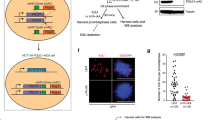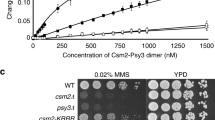Abstract
Cell cycle control, faithful DNA replication, repair and recombination are associated in a network of pathways controlling genome maintenance. In mammalian cells, inhibition of replication produces DNA breaks and induces RAD51-dependent recombination, in a late step. Here we examine whether the status of p53 affects this process in mouse L-cells containing a recombination substrate. We show that expression of the mutant His175p53 strongly stimulates recombination induced by aphidicolin, in a late step (kinetically related to the RAD51 step). Mutant p53 stimulates recombination induced by the replication elongation inhibitors (aphidicolin, hydroxyurea and Ara-C) but is without effect on recombination induced by the initiation inhibitors (mimosine and ciclopirox olamine). We compared the impact of several p53 mutations showing different effects on the G1 checkpoint and on recombination. We show that the mutant Pro273p53 protein, which does not alter the G1 checkpoint, strongly stimulates recombination induced by elongation inhibitors. These results show that p53 can act on recombination induced by replication arrest independently of its role in the G1 checkpoint. An action of p53 via the RAD51 pathway is discussed.
This is a preview of subscription content, access via your institution
Access options
Subscribe to this journal
Receive 50 print issues and online access
$259.00 per year
only $5.18 per issue
Buy this article
- Purchase on Springer Link
- Instant access to full article PDF
Prices may be subject to local taxes which are calculated during checkout




Similar content being viewed by others
References
Baumann P, Benson FE, West SC . 1996 Cell 87: 757–766
Baumann P, West SC . 1998 Trends Biochem. Sci. 23: 247–251
Bertrand P, Rouillard D, Boulet A, Levalois C, Soussi T, Lopez BS . 1997 Oncogene 14: 1117–1122
Bouffler SD, Kemp CJ, Balmain A, Cox R . 1995 Cancer Res. 55: 3883–3889
Buchhop S, Gibson MK, Wang XW, Wagner P, Sturzbecher HW, Harris CC . 1997 Nucleic Acids Res. 25: 3868–3874
Cavenee WK, Dryja TP, Phillips RA, Benedict WF, Godbout R, Gallie BL, Murphree AL, Strong LC, White RL . 1983 Nature 305: 779–784
Deng C, Zhang P, Harper JW, Elledge SJ, Leder P . 1995 Cell 82: 675–684
Donehower LA, Harvey M, Slagle BL, McArthur MJ, Montgomery Jr CA, Butel JS, Bradley A . 1992 Nature 356: 215–221
Dudenhoffer C, Kurth M, Janus F, Deppert W, Wiesmuller L . 1999 Oncogene 18: 5773–5784
Gottifredi V, Shieh S, Taya Y, Prives C . 2001 Proc. Natl. Acad. Sci. USA 98: 1036–1041
Hartwell L . 1992 Cell 71: 543–546
Hartwell LH, Kastan MB . 1994 Science 266: 1821–1828
Hollstein M, Sidransky D, Vogelstein B, Harris CC . 1991 Science 253: 49–53
Hyrien O . 2000 Biochimie. 82: 5–17
Jimenez GS, Nister M, Stommel JM, Beeche M, Barcase EA, Zhang X-Q, O'Gorman S, Wahl GM . 2000 Nature Genet. 26: 37–43
Lambert S, Lopez BS . 2000 EMBO J. 19: 3090–3099
Levenson V, Hamlin JL . 1993 Nucleic Acids Res. 21: 3997–4004
Levine AJ, Momand J, Finlay CA . 1991 Nature 351: 453–456
Liskay RM, Stachelek JL, Letsou A . 1984 Cold Spring Harb. Symp. Quant. Biol. 49: 183–189
Maacke H, Jost K, Opitz S, Miska S, Yuan Y, Hasselbach L, Luttges J, Kalthoff H, Sturzbecher HW . 2000 Oncogene 19: 2791–2795
Marmorstein LY, Ouchi T, Aaronson SA . 1998 Proc. Natl. Acad. Sci. USA 95: 13869–13874
Mekeel KL, Tang W, Kachnic LA, Luo CM, DeFrank JS, Powell SN . 1997 Oncogene 14: 1847–1857
Mizuta R, LaSalle JM, Cheng HL, Shinohara A, Ogawa H, Copeland N, Jenkins NA, Lalande M, Alt FW . 1997 Proc. Natl. Acad. Sci. USA 94: 6927–6932
Onno M, Nakamura T, Hillova J, Hill M . 1992 Oncogene 7: 2519–2523
Purandare SM, Patel PI . 1997 Genome Res. 7: 773–786
Rothstein R, Michel B, Gangloff S . 2000 Genes Dev. 14: 1–10
Saintigny Y, Delacote F, Vares G, Petitot F, Lambert S, Averbeck D, Lopez BS . 2001 EMBO J. 20: 3861–3870
Saintigny Y, Rouillard D, Chaput B, Soussi T, Lopez BS . 1999 Oncogene 18: 3553–3563
Scully R, Chen J, Plug A, Xiao Y, Weaver D, Feunteun J, Ashley T, Livingston DM . 1997 Cell 88: 265–275
Sturzbecher HW, Donzelmann B, Henning W, Knippschild U, Buchhop S . 1996 EMBO J. 15: 1992–2002
Susse S, Janz C, Janus F, Deppert W, Wiesmuller L . 2000 Oncogene 19: 4500–4512
Wiesmuller L, Cammenga J, Deppert WW . 1996 J. Virol. 70: 737–744
Willers H, McCarthy EE, Wu B, Wunsch H, Tang W, Taghian DG, Xia F, Powell SN . 2000 Oncogene 19: 632–639
Acknowledgements
We thank D Rouillard (Institut Curie, Paris) for FACS expertise. We are grateful to Drs P Bertrand, D Marsh, R Monnat for critical reading of the manuscript. Thanks are due to M Liskay for providing the pJS3-10 cell lines. Y Saintigny was supported by a fellowship from ‘la Foundation pour la Recherche Médicale’. This work was supported by Electricité de France, ARC (9822 and 9238).
Author information
Authors and Affiliations
Corresponding author
Rights and permissions
About this article
Cite this article
Saintigny, Y., Lopez, B. Homologous recombination induced by replication inhibition, is stimulated by expression of mutant p53. Oncogene 21, 488–492 (2002). https://doi.org/10.1038/sj.onc.1205040
Received:
Revised:
Accepted:
Published:
Issue Date:
DOI: https://doi.org/10.1038/sj.onc.1205040
Keywords
This article is cited by
-
p53 modulates homologous recombination at I-SceI-induced double-strand breaks through cell-cycle regulation
Oncogene (2013)
-
Chromosome instability and deregulated proliferation: an unavoidable duo
Cellular and Molecular Life Sciences (2012)
-
p53 in recombination and repair
Cell Death & Differentiation (2006)
-
p53 modulates homologous recombination by transcriptional regulation of the RAD51 gene
EMBO reports (2006)
-
Linking DNA damage to medulloblastoma tumorigenesis in patched heterozygous knockout mice
Oncogene (2006)



